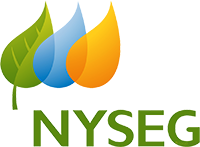
NYSEG History
NYSEG traces its history back to October 28, 1852, when six Ithaca businessmen founded the Ithaca Gas Light Company. By 1853 Ithaca's streets saw their first coal-gas lamps, the company supplied gas to 28 customers.
But by the 1890s, demand for of electricity in the home saw the rise of incandescent light bulbs, AC current, and centralized generating stations. Ithaca Gas Light naturally saw the light of this popular, new technology and quickly leaped to take over several local electric companies.
In 1906, a group of local utility investors formed Associated Gas & Electric (AGECO) as a holding company to gain control of the Ithaca Gas Light Company and 13 other companies. By 1914, these had been consolidated into just 4 companies. Between 1916 and 1918, these four fully merged into the New York State Gas and Electric corporation. Growth continued, however, and over the next 8 years, this corporation would swallow another 22 small New York companies. In 1929, the company changed its name one last time, becoming New York State Electric & Gas Corporation (NYSEG).
When deregulation started in New York in the late 1990s, NYSEG was required to sell off all its generation assets and become a distribution-only utility. In 2008, NYSEG became part of Iberdrola, USA. In December 2015, Iberdrola USA merged with UIL Holdings to create a new company, AVANGRID
Today, NYSEG delivers natural gas and electricity to more than 40% of upstate New York. NYSEG helps its New York communities by helping the people they serve. Their employees volunteer for organizations like American Red Cross and Habitat for Humanity. Meanwhile, the Avangrid Foundation supports New York nonprofits with rants, contributions, scholarships and matching gift programs.
NYSEG Service Territory
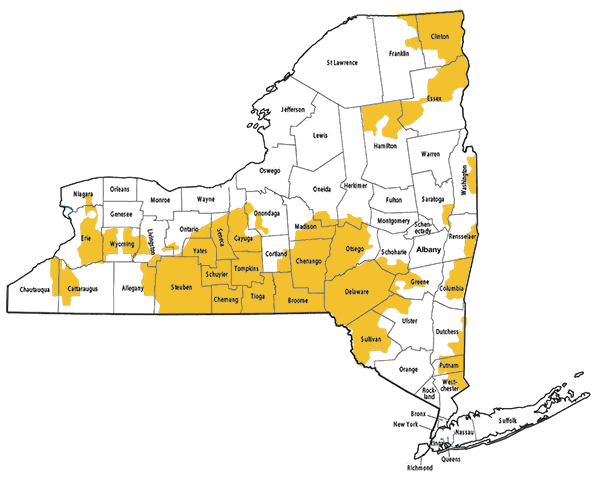
NYSEG serves approximately serves 268,806 natural gas and 902,593 electricity customers in some or all of these New York Counties:
| Allegany | Broome | Cattaraugus | Cayuga | Chautauqua | |
| Chemung | Chenango | Clinton | Columbia | Cortland | |
| Delaware | Dutchess | Erie | Essex | Franklin | |
| Greene | Hamilton | Herkimer | Lewis | Livingston | |
| Madison | Niagara | Oneida | Onondaga | Ontario | |
| Orange | Orleans | Otsego | Owasco | Putnam | |
| Rensselaer | Saratoga | Schoharie | Schuyler | Seneca | |
| Steuben | Sullivan | Tioga | Tompkins | Washington | |
| Westchester | Wyoming | ||||
NYSEG serves these cities:
Shop NYSEG Electricity Suppliers In Your Area.
Compare NYSEG Electricity Rates
Compare alternative supplier electricity rates
in the NYSEG service area.
- Enter zip code.
- Select "electricity".
- Choose "residential" or "business".
- Click "Shop for Rates".
In New York, electricity utility service territories may overlap in some zip codes. If the tool reports that it has found more than one serving your zip code, don't worry! Just choose your local utility from those listed.
You'll then get to see the listing of all the energy suppliers' plans available in your area, along with rates, term lengths, and links to more detail information.
How to Start New NYSEG Service
Getting set up with NYSEG is easy and convenient. Just visit the NYSEG web site to start your electric service. If you don't have an account, you can start one there and then follow the prompts to set up your service.
Customers can also apply to start service by calling NYSEG customer service (1-800-572-1111 ).
Be ready to supply:
- Service Address: The address where you want your service turned on or switched.
- The start date for electricity service.
- Personal Information: You will need to provide a valid form of identification (such as a driver's license or credit card) to validate your name and prior address. Otherwise, you will need to pay a deposit.
- The utility may also require proof of your occupancy date for service and ask you for a copy of your lease or deed.
Applicants for electric service must have paid in full all bills on their past NYSEG accounts or agree to a deferred-payment plan before a new account can be opened. NYSEG will notify you by letter within three business days after receiving your application if it has been denied. The letter will state the reason(s) for denial, exactly what you must do to be approved.
Will I Need to Pay a Deposit?
In New York, no utility can require any new residential customer to pay a security deposit as a condition of receiving utility service. The same applies to anyone over 62 year old. Lastly, if you receive public assistance, you will not need to pay a deposit.
However, the utility can require a deposit if:
- You're new seasonal or short-term customer.
- You are applying for a new NYSEG account within 60 days of closing an old account and the bill you get once every two months is 50 days overdue, and you have not paid at least one-half of what you owe.
- You were previously disconnected during the past six months.
Note: If you're aged 62 or older or you are receiving public assistance, supplemental security income, or additional state payments then you will not need to pay a deposit.
If you must pay a deposit -- NYSEG must notify you in writing within 3 business days about the specific reasons why you are required to pay a security deposit. NY law states that deposits cannot be greater than an estimated two months usage.
Customers have 20 days after the utilty sends the deposity request notification to make a payment. However, customers can pay the full deposit in installments over a 12 month period. NYSEG can hold deposits for residential service for 12 months. If the customer pays their bill in full and on time for 12 consecutive months, the deposit will earn interest.
Understand NYSEG Delivery and Supply Charges
In New York, residential customers pay for both the cost to deliver their electricity as well as for the amount of electricity supply that they use.
Understand NYSEG Zone Charges
New York State is a complicated place to supply and distribute electricity. For the that reason, the New York Independent System Operator (NYISO) operates New York's bulk electricity grid, administers the state's wholesale electricity markets, and provides comprehensive reliability planning for the state's bulk electricity system.
To keep the power flowing smoothly all across New York State, NYSIO has divided it into 11 load zones, labeled A through K.
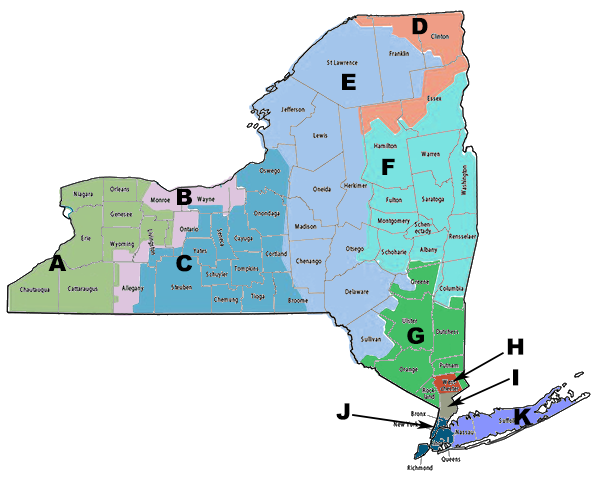
These load zones directly affect your electricity rates:
- New York electric utilities can operate in more than one load zone.
- For example, NYSEG serves zones A through H.
- Zones A, B, C, D and E are in NYSEG's West pricing zone.
- Zone F is in NYSEG's East pricing zone.
- Zones G, H and I lie in NYSEG's Lower Hudson Valley pricing zone.
- Both supply and delivery rates can be different in each zone. That means the rates you pay for your electricity will depend on which zone you live in.
What Are NYSEG PTC Charges?
When deregulation began in New York, all utilities that wanted to participate in consumer choice had to sell off their generators and limit their business to energy delivery. However, the NY PSC requires these utilities to provide electricity supply at a default rate to customers in their service territory who don't shop for a retail supplier. As a result, these utilities must purchase their electricity supply for the default rate from generator companies.
The NY PSC oversees NYSEG's default service rates since these represent generation supply costs that are passed directly through the utility onto their customers without mark up. This default rate is also called the "Price to Compare" or PTC.
Price to Compare (PTC)
The PTC default rate represents the actual price (generation + transmission) the utility pays for the electricity. In other words, it not only includes the generator company's price for making the electricity but also the cost to transmit it from power stations over high tension power lines to NYSEG's local electrical switch yards. From there, the electricity is distributed throughout the NYSEG local electrical grid for delivery to homes.
NYSEG's PTC rate is composed of the Supply charge. This rate is based upon market conditions during the billing period and will vary depending on where you live or do business. The NYSEG supply charge varies based on forecasted daily market prices. Consequently, the PTC monthly bill rates changes monthly. There are also other charges which include the Merchant Function Charge, the Clean Energy Standard Supply Surcharge, the Electricity Supply Reconciliation Mechanism, and other surcharges that add to the cost.
Because electricity demand fluctuates due to seasonal weather, NYSEG's Supply charge rates can also vary seasonally; low some months, higher the next -- especially in summer when air conditioning usage can soar. With the default PTC rate, you can never be too sure what you'll pay from one month to the next.
NYSEG Current PTC Standard Residential Rates:
- 7.450 cents per kWh in NYSEG West Zone, expires 10/31/2025
- 7.450 cents per kWh in NYSEG East Zone, expires 10/31/2025
- 7.450 cents per kWh in NYSEG Lower Hudson Valley Zone, expires 10/31/2025
How Much Do NYSEG Charges Cost?
The US Energy Information Agency reports that in 2019 New York State's residential customers used an average of about 577 kWh each month.
Therefore, an average residential PTC bill in the NYSEG West Zone roughly breaks down like this:
| Rate per 577 kWh Used | Monthly Customer Charge | Total | |
| PTC Supply Rate (excluding MFC and other surcharges) |
7.450 cents | 0 | $42.99 |
| Monthly Distribution Charges (excluding riders and other surcharges) |
$0.048500 per kWh | $16.05 | $44.03 |
| Total Bill in Zone A | $87.02 |
Understand New York Energy Choice
New York electric consumers are free to choose to buy electricity from Energy Service Companies (ESCOs). These alternative suppliers shop deals with different electricity generators on the wholesale market to offer competitive rates. As such, their rates are not controlled by NY PSC nor do they include the same complicated supply surcharges that NYSEG does in its monthly PTC rate. This way, ESCOs are able to offer competitively priced fixed rate plans for a variety of term lengths.
Though it can seem confusing, shopping electricity plans is an easy process. The trick is finding the one that meets your needs. That's why retail energy suppliers in New York offer two types of plans:
Your Energy Usage and Your NYSEG Bill
While your energy usage habits are unique to you, any upstate New York native will tell you that winters can be bitterly cold upstate and summers can be hot, hazy, and humid. While your biggest energy usage will usually follow the weather, all those other domestic activities, like cooking and cleaning, also add to your monthly bill.
- While most NY homes rely on natural gas for heating, only 12.2% of homes in the state rely on electricity for heat.
- New York residents spend on average 5% of their annual energy costs on air conditioning. About 53% of NY households have window or wall-mounted AC systems while only 20% have central AC.
- Approximately one third (32%) of home electricity usage goes to electronics, lighting, appliances, and air conditioning.
- The remainder of energy use goes to water heating, refrigeration, lighting, electronics, clothes dryers, cooking, and small appliances.
Want to learn more about your home energy usage? NYSEG customers can track 12 months of their home's electric usage plus other relevant information on each monthly bill or by logging on to your NYSEG account.
The most effective way to cut your energy bills is to reduce your usage by sealing your doors and windows against winter and summer drafts. Adding insulation to your attic, sealing and insulating your basement, and purchasing a programmable or smart thermostat also improve your home's energy efficiency and help cut your electric bills. Your utility company can provide a wealth of resources and may offer programs to help you improve your home's energy performance.
Understand Your NYSEG Bill
The typical NYSEG bill is about 5 pages long and contains many details that can be confusing to customers. However, there's lots of useful information to help you better understand your usage and what actually goes into your NYSEG rates. Below, we summarize the most important items you need to understand on a sample NYSEG Electric bill.
NYSEG Sample Bill
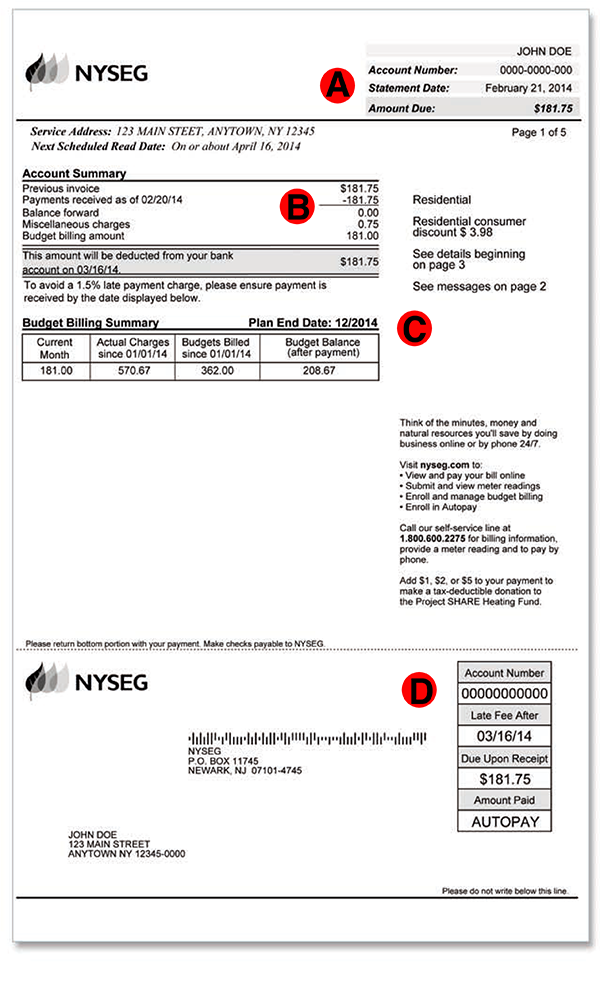
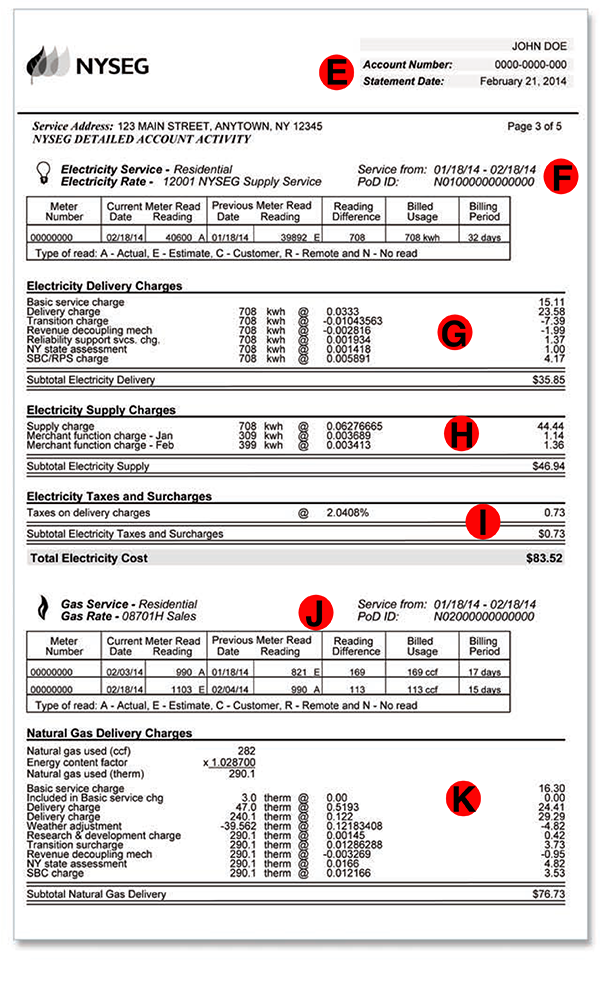
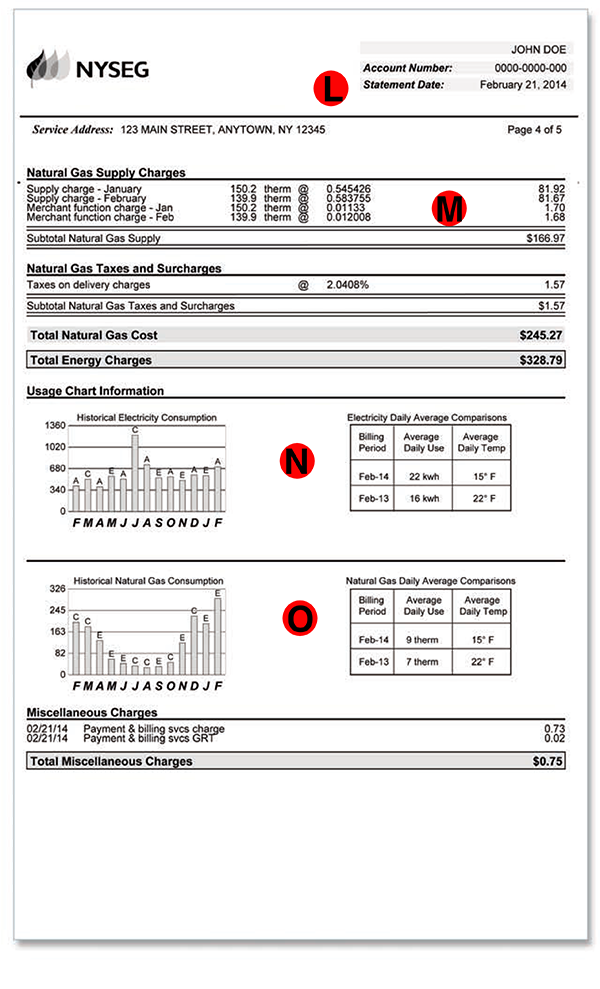
- A: Name, Account Number, Statement Date. This section shows your name, 11 digit NYSEG account number, the statement date, and the amount due.
- B: Account Summary. This section shows your previous charges, previous payment, any balance forwarded, and your current charges for NYSEG.
- C: Budget Billing Summary. Customers who enroll in Budget Billing can see a breakdown of their current balance for the year. Customers in the Budget Billing program pay the same amount for 11 months of the year.
- D: Pay Stub. This section This section shows the service address and the mailing addres to return this stub with your payment if you pay NYSEG by mail. To the right, it displays your customer account number and summarizes the total amount due for the current billing period. It also shows the date that late charges will take effect if the bill has not been paid by then.
- E: Page 3, Name, Account Number, Statement Date. This inform is show at the top of each bill page to help keep your bill organized. This page covers the details of your monthly usage. Electricity sections are marked by a light bulk icon, natural gas by a flame icon.
- F: Electricity Service and Account Activity. This section shows your service type and service rate (NYSEG residential rates are indicated by the "12001" code). This section also shows the service dates (usually 30 days). It also shows your Point of Delivery or POD number. You need to tell a retailer this number when you shop for an electricity supplier. The next section shows your meter information, including the current reading, the previous reading, dates, and the kWh amounts used.
- G: Electricity Delivery Charges. Here you can see how NYSEG's delivery charges breakdown. They include the customer charge, the delivery charge per kWh used, the transisiton charge, and other fees and rider surcharges approved by the New York PSC.
- H: Electricity Supply Charges. This section details the cost for NYSEG's PTC electricity. However, customers who have shopped and signed with an ESCO for their electricity will see that supply information here, instead.
- I: Electricity Taxes and Surcharges. This section shows taxes and any additional surcharges for your electricity.
- J: Natural Gas Service and Account Activity. Much like deregulated electricity, NYSEG also delivers natural gas and offers default supply service for natural gas. Likewise, customers can also shop for an alternative natural gas supplier. Usage amounts are in hundred cubic feet (ccf).
- K: Natural Gas Delivery Charges. This section displays the delivery charges per hundred cubic feet (ccf) used.
- L: Page 5, Name, Account Number, Statement Date. This page provides useful information on your annual and currently monthly gas and electricity usage charges.
- M: Natural Gas Supply Charges. This section details the cost for NYSEG's PTC natural gas rate. However, customers who have shopped and signed with an alternative gas supplier will see that supply price and usage breakdown here, instead.
- N: Electricity Usage Chart. Here you can find your electricty usage rate for the past 12 months. You can also
- O: Natural Gas Usage Chart. This section displays your natural gas usage for the past 12 months. Likewise, you compare the past month's consumption th the same period as last year.
Compare NYSEG Rates
NYSEG Coupons, Energy Promotions, Discounts, Rebates and Promo Codes
As your local electric utility, NYSEG offers several rebate and energy efficiency programs to help customers save money off their monthly bill by upgrading their home's energy performance. Some programs also offer money-saving incentives while others could make paying your monthly bills much easier during those expensive winter and summer months.
| Program Name | Program Type | Benefit |
| Clean Heat Rebate Program | Energy Efficiency Rebate Programs | NYSEG residential customers can take advantage of generous rebates on the purchase of high efficiency heating and cooling systems, including geothermal, heat pumps, central air conditioning, ductless systems, and water heating.
|
| Appliance Rebate Program | Energy Efficiency Rebate Program | Custmers can also find savings on energy-efficient lighting, smart thermostats, water-saving solutions, power strips, air filters, smart home devices and electric vehicle charger by shopping the NYSEG Smart Solutions on-line store. |
| Residential Energy Assessment & Upgrades | Sealed Energy Efficiency Programs | Sealed has teamed NYSEG to help qualifying customers receive rebates to help improve your home's energy efficiency.
|
| NYSEG Payment Arrangements | Bill payment assistance | NYSEG offers payment arrangements to allow residential customers to pay their account balance while remaining connected. There are payment plans with no down payment, fees or interest available.
|
| NYSEG Project Share | Bill payment assistance | If you're a residential customer that has exhausted all other forms of assistance and is facing a hardship (such as a Final Termination Notice, service shut off due to nonpayment, etc) you may be eligible. As long as funding remains available, eligible recipients may receive a one time benefit of $350 toward a heating expense. Applicants must contact a NYSEG customer service representativeve for a referral. Money for Project Share comes from funded with support from NYSEG customers as well as the Avangrid Foundation. The fund is administered by HeartShare Human Services of New York. |
| Low Income Grants | Bill payment assistance | Home Energy Assistance Program (HEAP) provides both regular and emergency financial grants to eligible households to help pay heating and/or utility bills. HEAP benefits are funded by the federal government and administered through the New York state Department of Social Services. NYSEG customers who receive a HEAP benefit during the HEAP season will be issued a monthly bill credit on their NYSEG bill for a maximum of 12 months based on service type. Energy Assistance Program (EAP) is designed to help eligible customers gain control of their energy bills. It has two levels of assistance, bill credits and arrears forgiveness. EAP bill credits are available automatically to any customer who receives a HEAP benefit. A limited number of EAP participants can apply for the EAP arrears forgiveness program.
|
| Em-Power New York Energy Efficiency Upgrades | Residential Energy Efficiency | NYSEG has partnered with New York State Energy Research and Development Authority (NYSERDA) to offer HEAP qualified customers no-cost energy efficiency upgrades to help reduce their electric bills.
|
Read NYSEG Reviews
Since NYSEG serves a large east coast market segment, New York residential customers throughout the state can get a better picture of how good a job it does by comparing it to similar sized utilities. While NYSEG is not accredited with the BBB, the utility fell below the average range for J.D. Power's 2020 utility residential customer satisfaction study.
| NY Energy Ratings Score | Better Business Bureau | J.D. Power 2020 Electricity Utility Study |
| N/A | Not Accredited, A- |
707 of 1000 pts |
How Do I Get the Cheapest NYSEG Rate?
Shopping for a new NYSEG Customer Choice Plan can seem bewildering at first. Once you understand how it works, though, it's an easy and straightforward process. That said, you should have these three things with you when you shop for electricity.
- Your current bill. Your past usage per billing period can help you estimate a how much a plan might cost you each month.
- The current NYSEG PTC rate. Knowing the current NYSEG supply price lets you compare rates offered by retail energy suppliers. This way, you can get a better feel for what suppliers are offering, for how long, and if any of their incentives make their price work for your family's need.
- Your NYSEG customer account number. You'll also need your load zone, billing cycle information. These are found with your This 11 digit account number on page 2 of your bill. Having these handy lets you sign up with a retail supplier right away.
NYSEG Shopping Questions
The best way for a NY energy customer to avoid making a bad choice it to ask the right questions. That way, you can learn exactly the information that can save you money. When you shop for electricity service in New York, always be sure to ask these important questions:
- Is the rate variable or is it fixed?
- How long does the plan contract term run?
- Does the plan include any recurring monthly charges?
- Is the rate competitive with the current NYSEG supply rate annual average? Remember that NYSEG's rate changes monthly!
- Does the plan have an early cancellation fee?
- Does the supplier offer any customer incentives or rewards programs?
- What happens when the contract with the ESCO expires?
Other Commonly Asked New York Electricity Questions:
Who bills me? NYSEG sends a single bill that outlines and adds up your monthly charges.
What are the Terms of Service? In NY, Customer Choice Plans must include Terms of Service that explain and identify specific charges and any fees a customer will face when they sign up for an electricity plan. Not all suppliers have the same terms. That's why all New York energy choice customers should read and understand the terms of service and contract summary for any plan they are interested in before they sign on to the plan.
What is the Right of Rescission? According to the New York ESCO Consumers Bill of Rights, residential customers have the right to rescind or cancel an agreement with an ESCO within three days of receiving the agreement without facing a penalty.
What are early termination fees? Switching retail suppliers before a contract ends can involve paying early termination fees. These can take a big chomp out of your checking account you if choose to switch retail providers before your plan contract ends.
Where can I find more information on my usage? NYSEG customers can request 12 months of their energy usage free of charge. This is most easily available through your NYSEG online account.
Read NYSEG Customer Reviews
Compare NYSEG Electricity Rates in Your Area
Bill Questions? Electricity Out? Contact NYSEG!
Having problems or interruptions with your NYSEG electricity? Here's the proper people to call.
NYSEG Billing Problems
First thing to do is contact NYSEG Customer Service at 1-800-572-1111 and learn what options you have. If you are having trouble paying your monthly bill then call NYSEG's Bill Payment Center:1-888-315-1755. Have your account number ready. You can also apply for payment methods online through your NYSEG account.
Important Billing Options to keep in mind:
- Budget Billing: The NY PSC requires all New York public utilities to offer "budget billing" where annual electricity costs are averaged out over the cost of the year. This ensures that customers aren't presented with unexpectedly high bills at peak times.
- Need Extra Time? The One Less Worry program can place your bill on hold for 30 days should you or a household member be hospitalized.
NYSEG Emergencies and Outages
All power lines are extremely dangerous! Never attempt to move a downed power line by yourself. Call 911 and then notifiy NYSEG.
- Report downed powerlines and other safety hazards immediately to NYSEG at 1-800-572-1131.
- You can also report downed lines or outages at NYSEG's website.
- Check NYSEG's current electric outages as they are being repaired.
NYSEG Service Area Providers
| Company | Rating | Phone |
|---|---|---|
| Frontier Utilities | (3.4/5) |
|
| Direct Energy | (3.3/5) |
(866) 645-2643 |
| Constellation | (3.3/5) |
855-798-9075 |
| Spark Energy | (3/5) |
(866) 605-8658 |
| Major Energy | (2.9/5) |
(866) 607-4735 |
| Verde Energy | (2.8/5) |
|
| APG&E | (2.5/5) |
866-606-2584 |
| Kiwi Energy | (0/5) |
|
| Spring Power & Gas | (0/5) |
|
| 9 results | ||
New York Zip Codes with the Cheapest Electricity Rates
The Latest NYSEG News
Cooling Without High Electric Bills There are better ways to cut your cooling bills while staying comfortable and saving money. Check out our five best tips. There are so many things to enjoy... [read more]
Prep Your Air Conditioner for a Hot Summer Find out how to inspect and clean your AC system components with these money saving tips. Learn what to watch for to help you catch problems before... [read more]
NY Government Can’t Agree on HEAT Act New York's proposed Heat Act is fanning the flames of debate among lawmakers. It may benefit consumers and green energy, but utilities face costs they'll... [read more]